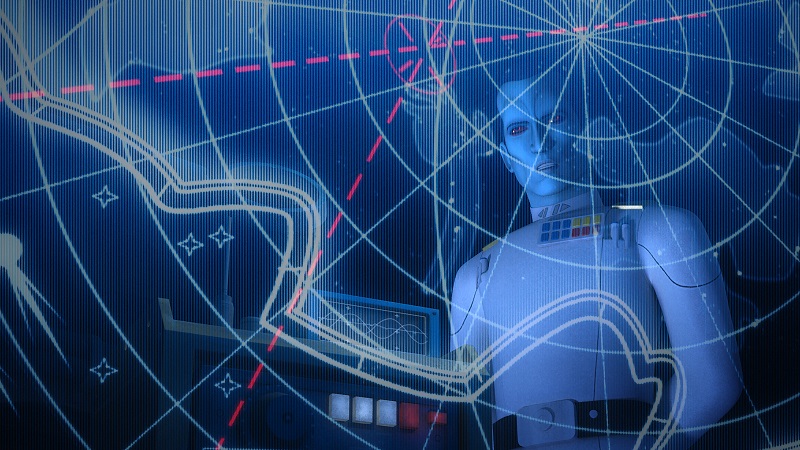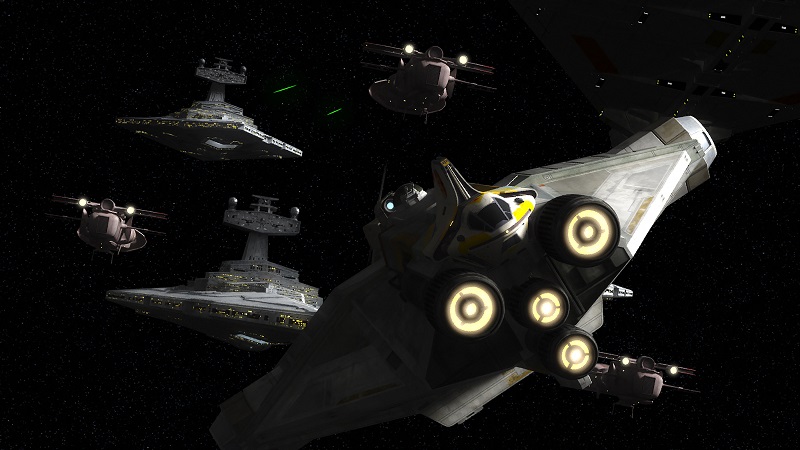Star Wars Rebels: Zero Hour Review
 In “Zero Hour” Grand Admiral Thrawn nearly wipes out the fledgling rebellion against the Empire and Rebels nearly produces a season finale on par with last year’s “Twilight of the Apprentice.” The team behind Rebels definitely gave it all they had, but were undermined by factors of their own choosing under the umbrella of “what’s at stake?” Not to downplay the loss of one particular rebel commander, but at the conclusion of the finale the viewer was left wondering, “Well, what’s changed?” The absence of a strong answer to that question is what separates “Zero Hour” from its predecessors.
In “Zero Hour” Grand Admiral Thrawn nearly wipes out the fledgling rebellion against the Empire and Rebels nearly produces a season finale on par with last year’s “Twilight of the Apprentice.” The team behind Rebels definitely gave it all they had, but were undermined by factors of their own choosing under the umbrella of “what’s at stake?” Not to downplay the loss of one particular rebel commander, but at the conclusion of the finale the viewer was left wondering, “Well, what’s changed?” The absence of a strong answer to that question is what separates “Zero Hour” from its predecessors.
It’s not to say that “Zero Hour” was not an enjoyable episode, it was a very enjoyable episode, but one that had all the finality of an incredible mid-season break episode rather than a season-ending affair. It drew upon many of the ingredients which had made the back half of Rebels’ Season Three an exciting run, from seeing Grand Admiral Thrawn executing flawless deduction and strategy to Mandalorian warriors demonstrating why their armor is exceptionally functional and not just all looks. It even drew upon sacrifice and loss with the valiant death of Commander Jun Sato, which “Fire Across the Galaxy” threatened with Kanan and which “Twilight of the Apprentice” set its dramatic crescendo around. Ultimately, though, the aforementioned question dampens what should have been the best finale yet by the Rebels crew.
In the briefest of recaps, Admiral Thrawn finally captures Agent Kallus in the role of Fulcrum, using his attempted broadcast along with other intelligence to locate the planet of the rebels’ base. There, the rebel fleet is amassing for its first true major military strike against the Empire with General Jan Dodonna bringing his fleet to join Sato’s for a mission to attack the Empire on Lothal. Thrawn disrupts this plan by sending a fleet of Star Destroyers along with interdictor cruisers, last seen in “Stealth Strike,” to prevent the rebels from escaping via hyperspace. A siege ensues, with Sato sacrificing himself and the rebel carrier ship (from “Homecoming”) to allow Ezra to fly away to get help. While Ezra successfully recruits Sabine and some Mandalorians, Kanan implores the Bendu to help the rebels fight the Empire. The Bendu, in true grumpy old mystical Force being fashion, simply gets mad at his quiet home being interrupted and chooses to attack everyone with a Force-driven thunderstorm. It allows the rebels to escape Thrawn on the planet, and Ezra and Sabine help them to escape to hyperspace by destroying the last remaining interdictor cruiser.
 Within this story is beautiful animation, one of the more striking animated space battles seen since The Clone Wars, and an increasingly successful job of diversifying the humans seen in the background of the show. What’s not encapsulated in “Zero Hour” is much in the way of change. Kallus is forced to officially leave the Empire to join the rebellion, but he did this in spirit some time ago. Thrawn scored a good victory against the rebels, undermined by the idiocy of the now deceased Admiral Konstantine, but otherwise presumably remains in the same job as before – wiping out the remaining rebel threat in the Lothal region. Governor Pryce presumably remains the governor of Lothal and the rebels, who suffered no major losses outside of Commander Sato, essentially find themselves in the exact same position as they were in Season Two.
Within this story is beautiful animation, one of the more striking animated space battles seen since The Clone Wars, and an increasingly successful job of diversifying the humans seen in the background of the show. What’s not encapsulated in “Zero Hour” is much in the way of change. Kallus is forced to officially leave the Empire to join the rebellion, but he did this in spirit some time ago. Thrawn scored a good victory against the rebels, undermined by the idiocy of the now deceased Admiral Konstantine, but otherwise presumably remains in the same job as before – wiping out the remaining rebel threat in the Lothal region. Governor Pryce presumably remains the governor of Lothal and the rebels, who suffered no major losses outside of Commander Sato, essentially find themselves in the exact same position as they were in Season Two.
In contrast, at the end of Season Two, Kanan suffers a life changing injury to his vision, Ezra appears to be lured toward the Dark Side, Ahsoka Tano is lost, Maul is reintroduced as a new villain, all known Inquisitors are killed, and Darth Vader appears to have successfully stamped down on the Jedi element of the rebel threat and moves on (with a bit of a limp). “Twilight of the Apprentice” resolved a lot and opened the door to captivating possibilities. Even “Fire Across the Galaxy,” while ending on a bit of a saccharine note of Ezra broadcasting a message of hope to the galaxy to resist the Empire, saw the rescue of Kanan, who as a Jedi perpetually has a risk of death connected to him with regard to Yoda’s words in Return of the Jedi in mind and the reintroduction of Tano. Likewise, it killed off the big bad of the season, the Grand Inquisitor, and saw the crew of the Ghost take one more step toward becoming a true rebel cell. Virtually every character in “Zero Hour,” though, emerged essentially unchanged and unscathed, which unfortunately is partially true for Season Three with exceptions like Sabine, Maul, and Agent Kallus. “Zero Hour,” in its failure to truly end with any real changes, is in that manner an appropriate finale for the season.
The biggest regret of “Zero Hour” is that Season Three had some stupendous episodes, such as “Twin Suns,” “Trials of the Darksaber,” and “Through Imperial Eyes,” and the finale was just unable to cast a shadow of similar length as its season’s predecessors. Perhaps with storylines bleeding into Season Four writers were unable to move the game pieces more significantly in “Zero Hour” than they would have if a clean break had been imagined with new storylines for the next season. The biggest balancing act Rebels must deal with is telling the story of the rise of the Rebel Alliance into what we see in Rogue One and A New Hope, while building credible barriers and serious challenges for the rebels to overcome along that path to keep things interesting. On a smaller scale, in lieu of big threats to the overall story of rebellion building, developing the stories and characterizations of its heroes, as it did beautifully with Sabine Wren this season. “Zero Hour” in this regard was imbalanced, which is unfortunate, as every season finale should leave the fandom hungry for the premiere of the following season. “Zero Hour” joins the previous two season finales as the weakest of the bunch, but at least not for trying its best to go out with a good solid bang.
For more on “Zero Hour,” check out the episode guide on StarWars.com.
- Star Wars The Mandalorian – The Reckoning and Redemption Review - January 15, 2020
- Star Wars: The Mandalorian –The Prisoner Review - January 11, 2020
- Star Wars Resistance – Station to Station Review - January 7, 2020











